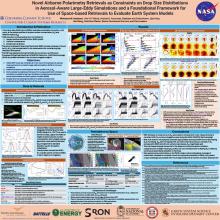Novel Airborne Polarimetry Retrievals as Constraints on Drop Size Distributions in Aerosol-Aware Large-Eddy Simulations and a Foundational Framework for Use of Space-based Retrievals to Evaluate Earth System Models
McKenna
Stanford
PNNL
Poster
Polarimetry measurements from the airborne Research Scanning Polarimeter (RSP) provide retrievals of cloud-top drop size distribution (DSD) characteristics including effective radius (Reff) and cloud droplet number concentration (Nd). RSP retrievals from the NASA CAMP2Ex field campaign are used here alongside in situ measurements as constraints on large eddy simulations (LESs) of a tropical cumulus congestus case study. Simulation input includes height- and size-resolved aerosol measurements with large-scale forcing harvested from a mesoscale simulation. Observed characteristic profiles whereby Nd (Reff) decreases (increases) with increasing cloud top height are reasonably reproduced in simulations employing bulk and bin microphysics schemes and are modulated by collision-coalescence, the height-resolved aerosol profile, and entrainment and mixing. However, both schemes and additional sensitivity experiments show a pronounced low-bias in Reff relative to RSP and in situ data. In situ probe measurements demonstrate that source regions for this bias occur between sizes of 10-30 𝜇m, indicating potential structural limitations in the ability for bulk autoconversion schemes or the bin scheme’s collision kernel/efficiencies to appropriately represent DSD broadening mechanisms. This consistent bias has important implications for radiative transfer calculations in Earth System Models (ESMs) and space-based radar/lidar simulators. We posit that the demonstrated framework offers a viable benchmark simulation ensemble for exploring congestus DSD evolution, with next steps targeted towards evaluating identically forced simulations in single column model (SCM) mode of ESMs. Extension of this framework is coincidentally useful for interpreting retrievals from the recently launched Plankton, Aerosol, Cloud, Ocean Ecosystem (PACE) satellite, with two polarimeters onboard that provide similar cloud-top and aerosol retrievals as RSP but with a substantially larger footprint. Synergizing sampling and comparison across in situ observations, RSP, LES, space-based polarimeters, and ESMs is discussed as a foundational pathway for improving polarimetry constraints on simulations across scales and the development of space-based polarimetry simulators.

stanford-mckenna-poster.pdf
(3.46 MB)
Meeting homepage
